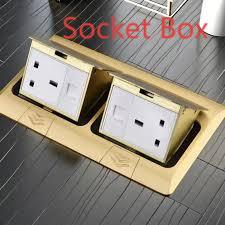Electrical Socket Box Innovations by Nante: Durable, Intelligent Power Solutions

A well-specified Electrical Socket Box placed near equipment reduces cable runs and improves safety, and choosing the right Electrical Socket Box at the design stage prevents field modifications and protects systems from environmental exposure. Thoughtful placement and correct specification cut installation time, simplify maintenance, and help teams meet regulatory requirements while extending equipment lifetime.
Defining the right enclosure for the environment
Understanding the site conditions is the first step. Determine exposure to moisture, dust, chemicals, or UV radiation and select an ingress protection rating accordingly. Indoor, sheltered locations often require lower IP ratings than exterior or washdown areas, where IP65 and above are common. Also evaluate mechanical risks—impact, vibration, or accidental contact—that influence housing material choices and impact ratings.
Materials, seals, and long-term durability
Material selection drives lifecycle performance. UV-stable thermoplastics resist embrittlement in sunlight, while stainless steel and powder-coated aluminum survive corrosive or high-impact environments. Seal geometry and gasket compression methods determine how long a box remains watertight; boxes with replaceable gaskets simplify maintenance. Fasteners and hinge designs with captive screws prevent lost parts during service, and robust latches or locks deter tampering in public or high-traffic areas.
Electrical performance and thermal considerations
Power modules, contactors, or surge protectors installed inside a socket box generate heat that must be managed. Choose enclosures with sufficient internal volume, thermal paths, or optional vents if allowed by the environment. Contact materials and terminal designs affect resistance and temperature rise—select high-conductivity alloys and plated contacts for low-loss performance. Where high currents or transformers are present, account for derating and spacing to avoid overheating and insulation stress.
Nante modular systems for simplified maintenance
Nante offers modular families that enable quick insert swaps and field upgrades without replacing entire housings. Interchangeable power, signal, and protective inserts reduce spare-part inventories and shorten repair time. Clear labeling, pictorial wiring guides, and standardized mounting footprints help technicians perform safe, fast maintenance. Modular approaches also allow owners to repurpose locations as needs change, adding monitoring or surge modules without complicated retrofits.
Installation practices that protect integrity
Proper cable gland selection and strain relief are critical to preserve seals and avoid conductor fatigue. Follow terminal torque specifications to maintain low resistance connections, and route cables to minimize sharp bends near entries. Use appropriate anchors for the substrate and seal mounting penetrations against water ingress. During commissioning, document cable types, gland sizes, and torque values so subsequent servicing follows the original design intent.
Testing, certification, and compliance checklist
Request test reports for dielectric strength, temperature-rise, and ingress protection that match your application. Confirm that products meet regional and international standards relevant to voltage, current, and environmental exposure. For specialized settings—food processing, medical, or marine—ask for additional material declarations, antimicrobial finishes, or salt-spray resistance data. Compliance reduces liability and helps pass inspections smoothly.
Smart capabilities and future-proofing options
Consider boxes that accept monitoring modules for temperature, moisture, or load. Remote sensors can alert maintenance teams to abnormal conditions before failures occur, enabling predictive approaches. Design choices that include spare knockouts, accessory rails, and modular inserts help future-proof installations so evolving needs can be met without complete enclosure replacement.
Maintenance schedules and lifecycle management
Incorporate gasket inspections, fastener torque checks, and contact condition assessments into routine maintenance. Replace gaskets and consumables before visible degradation to avoid unplanned downtime. Keep a compact spares kit—common inserts, gaskets, and screws—on site. Maintain clear records of installations and servicing to streamline troubleshooting and ensure consistent upkeep practices across facilities.
Final recommendations and resources
Selecting the appropriate electrical enclosure balances immediate cost against long-term reliability, safety, and maintainability. Prioritize tested products with modular options, replaceable seals, and accessible service features to lower lifecycle costs and protect uptime. For detailed specifications, configurators, and product families tailored to your application, visit www.nante.com/product/
- Art
- Causes
- Crafts
- Dance
- Drinks
- Film
- Fitness
- Food
- Spellen
- Gardening
- Health
- Home
- Literature
- Music
- Networking
- Other
- Party
- Religion
- Shopping
- Sports
- Theater
- Wellness


